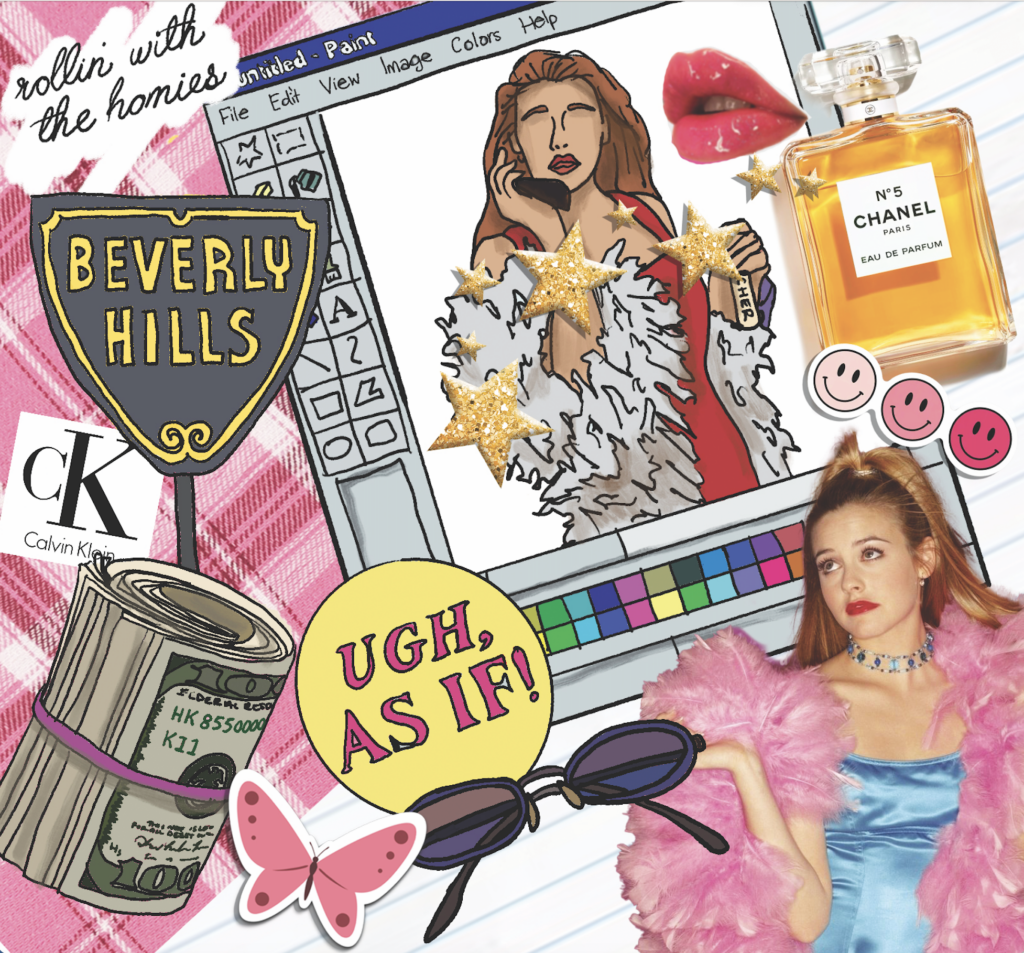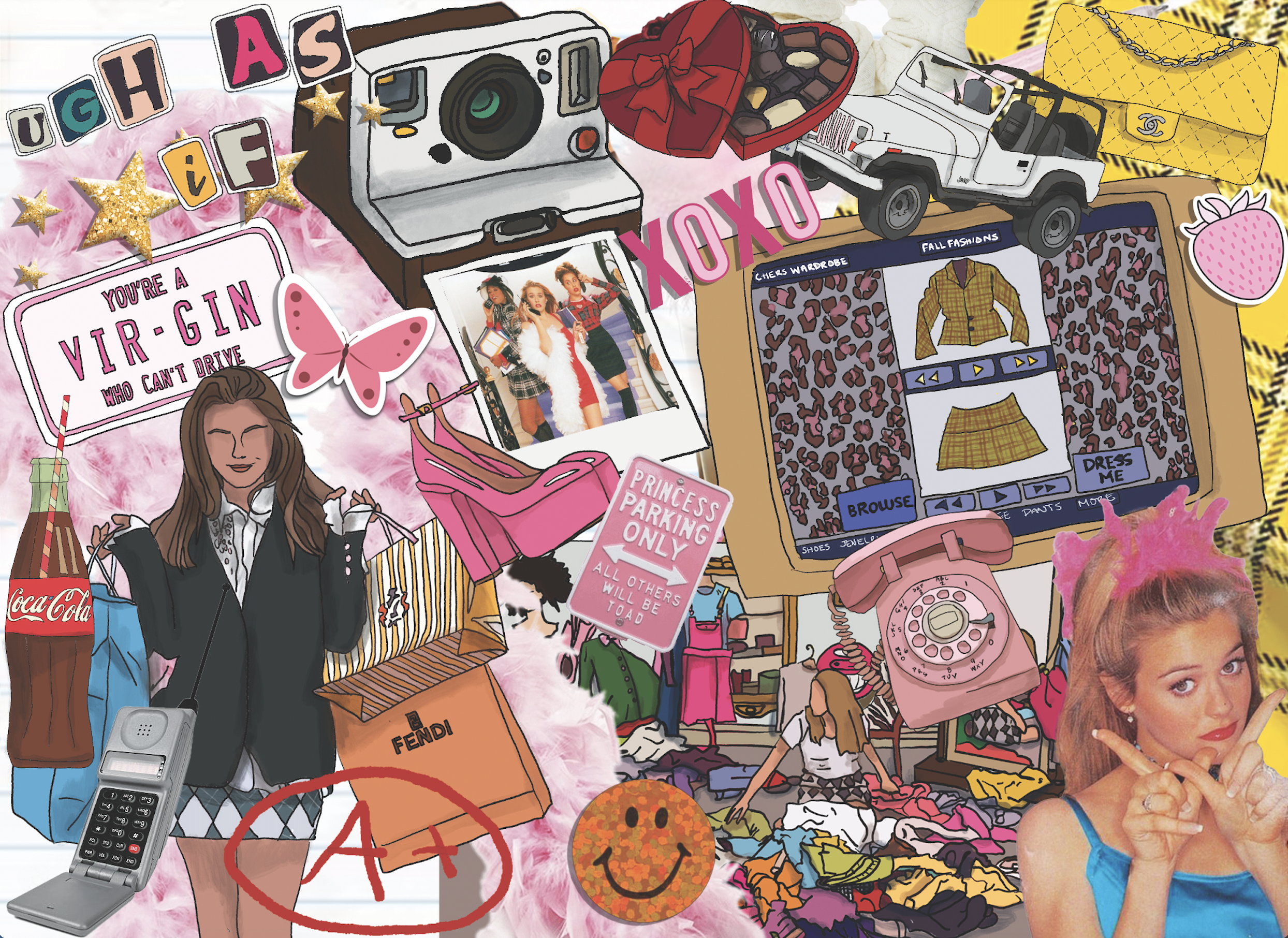In the summer of 1995, Clueless was born. From the ’90s lingo to the chunky cellphones to the back-in-style fashion, the quintessential teen movie defined its Gen X and millennial audience. Perhaps most importantly, though, it gave us a peek into a possible future of fashion with Cher’s digitized closet.
In a now-famous scene, Cher wakes up one morning and walks us through her “way normal” teenage girl life. She gets up, brushes her teeth and picks out her school clothes. But the way she chooses her outfit looks incredibly modern for its time: she sits in front of her behemoth of a desktop computer and flips through a wardrobe program that has every item of her clothing catalogued and it automatically generates outfits for her. (When she dares to make her own, it hits her with a glaring “MIS-MATCH!”) Although it wasn’t known as an “app” at the time, the computer-enabled closet feature allowed Cher to, essentially, land on a fashionable look with minimal effort.
Though the scene was brief, it had a lasting impact, with countless fans still lusting for the kind of tech that would finally gift us the power of the Clueless closet. Although various apps have been developed with the intention of providing that experience, there hasn’t been a widespread, viable and user-friendly option to reach the mass market. All us fans really want is a little curation.
“The high-tech aspect is obviously really interesting,” says Sajna Massey, founder of Toronto’s Couth Studios, an artificial intelligence–driven fashion brand. “But what I took from it was the [common] panic in the morning, where you’re thinking, Oh my god, what am I going to wear? And that piece of technology really simplified it. For me, it’s not necessarily the kitschiness of it, but the representation of how tech can make our lives so much easier, even when it comes to getting dressed in the morning.”
Fashion innovators are still trying to solve that problem, with the most recent attempt being AI-driven try-on and virtual styling services, which are becoming increasingly pervasive—and powerful—as retailers look to differentiate themselves in a fiercely competitive and ever-evolving e-commerce space. Beauty, too, has leaped into the future, with apps like L’Oréal and ModiFace’s skin diagnostic and virtual makeup try-on feature. So when is it our wardrobe’s turn?
Matt McGowan, general manager of Snapchat Canada, focuses on retail and luxury fashion as the company works to deepen the connection between shoppers and the brands that they love, using augmented reality (AR) technology, which facilitates virtual try-ons, augmenting for everything from the scale to colour. He says, “Brands are using AR to allow consumers to experience their brand or items in an immersive way without having to leave the comfort of their own home. It’s something that, back in Cher’s day, we could only really dream about.”
It certainly brings us closer to her online closet. As Snapchat partners with brands to provide those AR capabilities, it continues to develop and sharpen its camera-enabled technology when it comes to focusing on features, fine details, fabrics, colourways and fit. As a result, consumers are increasingly likely to make smarter purchases and more of them.
Enabling consumers to try on clothing in a personalized process earns trust. In fact, the company recently reported that 66 per cent of luxury shoppers globally said they feel more comfortable trying a luxury product using AR than in-store.
But the integration between fashion and tech isn’t just about providing complex and technical solutions like AI and AR. It also embraces the concept of innovation, amplifying companies that aren’t significantly dependent on technology but are significantly enhanced for the end user because of it.
Consider Zero Collective, Canada’s first private members’ club for renting high-end designer bags. That’s right: it provides members access to hand-picked classic, vintage and archive pieces all while promoting sustainability. Founder Gina Yoo immigrated to Canada from South Korea in 1998, living for a period in New York City, where she discovered both the appeal of designer goods and the limits of access (and closet space, natch).
The specific inspiration for Zero Collective came from an impulse purchase of a neon Chanel bag while Yoo was travelling, and her subsequent realization, only once she got home, that it wasn’t as practical as she had hoped. It sparked the idea to offer luxury customers exactly what they need in the digital age—a way to shop online but also be able to touch, feel and interact with the item by renting it for 30 days before committing to a full purchase. (Customers can also sign up and opt to rent or rotate each month.)
It’s a prime example of “phygital retail,” which is how some tech and marketing insiders refer to the magic that happens when digital and physical shopping synchronize.
But that’s not the only aspect of tech that Yoo leveraged while building her platform. She explains, “We’re able to scrape all of the data around the web to look at the pricing of bags by looking at what is out there from competitors and comparables, both historical and current. Without AI, we probably couldn’t have built this.”
Although AI isn’t the backbone of the company, it certainly provides an expedited solution to pricing, thus democratizing access to luxury goods for the everyday consumer.
There is a misunderstanding around how much AI can actually augment human functionality to help us
Zero Collective also speaks to the cultural zeitgeist in a larger way, by engaging in the sharing economy, which was originally popularized by home-sharing platform Airbnb and ride-sharing app Uber.

“It’s a fascinating new market,” says Yoo. “It’s about making the most out of everything that is available to you. I think that’s a really cool mindset.”
That being said, there are good reasons why no one has yet been able to replicate the technology Clueless production designer Steven Jordan imagined back in 1995.
“There is a misunderstanding around the capabilities of AI and how it can actually augment human functionality to help us,” says Massey, drawing from her background in engineering and retail technology. “And the other thing is fear around job loss. As an example, all of our clothes are designed with AI. A designer could say that we’re trying to take their job away, but the reality is that AI is not advanced enough today to replace those jobs end to end.”
As a 2023 report from McKinsey & Company found, AI will lead to some job losses, but “the categories most exposed to generative AI could continue to add jobs through 2030,” and that includes the fashion industry. In fact, as some fashion experts have noted, AI can’t run smoothly in a creative industry without human oversight.
AI ideation still requires significant designer-led input and engagement to take that item to production, which isn’t bound to change anytime soon. When it comes to the consumer, then, the goal should be developing personal taste and style.
Get the
Three from 3
newsletter
Join our global community of sharp, curious thinkers to receive a carefully curated email of the three most important things to read, see and do this week.
Listen and learn.
Tune into Third Culture Leaders, a podcast hosted by our co-founder and publisher, Muraly Srinarayanathas.
Explore how leaders skillfully navigate multiple cultural landscapes, leveraging their diverse backgrounds to drive innovation and change.
“The biggest thing I want to see is a deeper connection between consumers and the
clothes they wear,” says Massey. “I’m hoping that people will wear their pieces more than
[they do] today; right now, the average is just seven times. I think that’s the first piece—rebuilding the connection between a person and their clothes.”
Although we don’t have the exact same technology that Cher had access to over 30 years ago thanks to the magic of Hollywood, it is possible that today’s tech could contribute to an even better version, one that is likely in the not-too-distant future.
“You could say Cher’s closet would be a lot more advanced thanks to technologies like AI and AR,” says McGowan. “Her wardrobe would be a lot more diverse, customizable based on her measurements, tailored to her daily activities or her mood, even programmed to be aligned with the weather or her body temperature. She had a vision, and it’s a bit like she saw into the future.”
And by the sounds of it, a future that is—finally—ever closer and even better.
